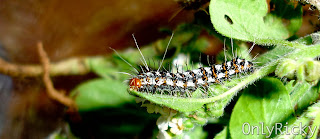FOUND IN VILA CHÁ
ENCONTRADA EM VILA CHÁ
 |
| 22-08-2013 |
 |
| 23-08-2013 |
 |
| 30-08-2013 |
 |
| 05-10-2013 |
Spurge Hawk-moth aka
Hyles euphorbiae
I decided this summer go to the sand-hills to find these. At first I found it was very hard and difficult to me to realize where they were. I knew their host plant
Euphorbia characias, which can be found between the sand hills, and I never found them. It was really difficult because they are very colorful and get a redish style which make a great camouflage on the plant because on its end it is red sometimes. Luckily I've found one big one in a plant and collected it. Other days I seek for more and found 2 more. When it was, per say, full grow and ready to pupate, it buried itself in the sand, but not that deep as I can say. Some weeks later I got the surprise of one hatch before the spring. Still, it is hot, so it can still make a new generation. This one is a female. Females their fore-wings are very pinkish, while males are so pink.
It was fun and challenging to grow these, and they fed even on field
Euphorbia spp.The moth pictures were taken with a digital camera.
Decidi este verão encontrar estas nas dunas. No inicio foi difícil para mim ver onde as poderiam estar. Eu sabia que elas comiam de
Euphorbia characias que se encontra entre, ou antes das dunas, mas nunca as encontrei, porque elas são bastante coloridas e têm um tom vermelho, coisa que no caule da planta hospedeira no final também tem zonas vermelhadas. Por sorte encontrei uma bem grande. Depois de encontrar uma decidi voltar à busca e encontrei mais 2, e desta vez mais rápido. Por assim dizer, quando ela estava bastante nutrida e preparada para fazer a pupa, enterrou-se na areia, mas não muito fundo. Algumas semanas mais tarde tive a surpresa de uma delas me nascer antes da primavera. Talvez porque esteja a fazer algum calor agora, e ainda vai a tempo de fazer uma próxima geração. Esta é uma fêmea pois as fêmeas têm por baixo das asas e no resto do corpo por baixo muito rosa, enquanto que o macho nem tanto.
Foi bastante interessante e produtivo crescer estas, mesmo em casa, pois alimentavam-se de
Euphorbia spp do mato.
As fotos da mariposa foram tiradas com uma máquina digital.







































.jpg)
.jpg)


.jpg)









